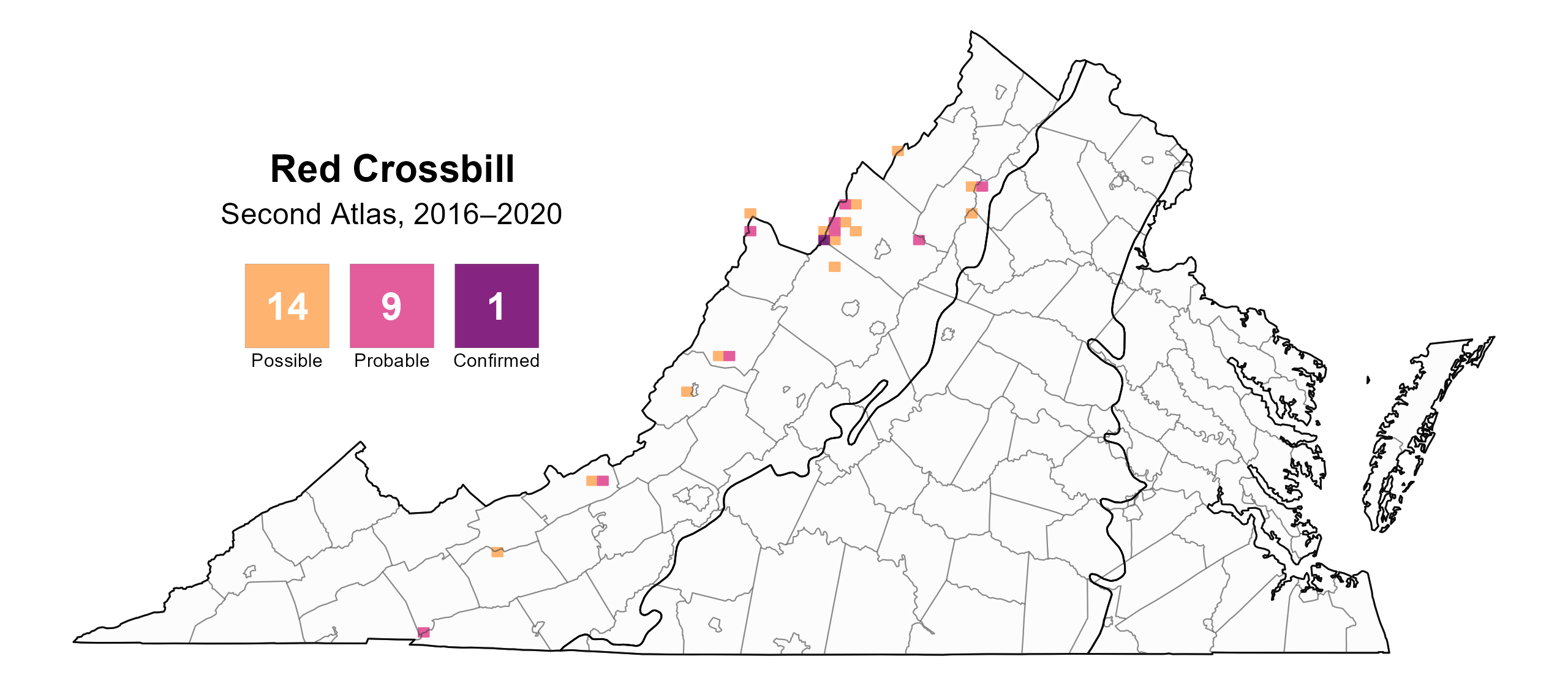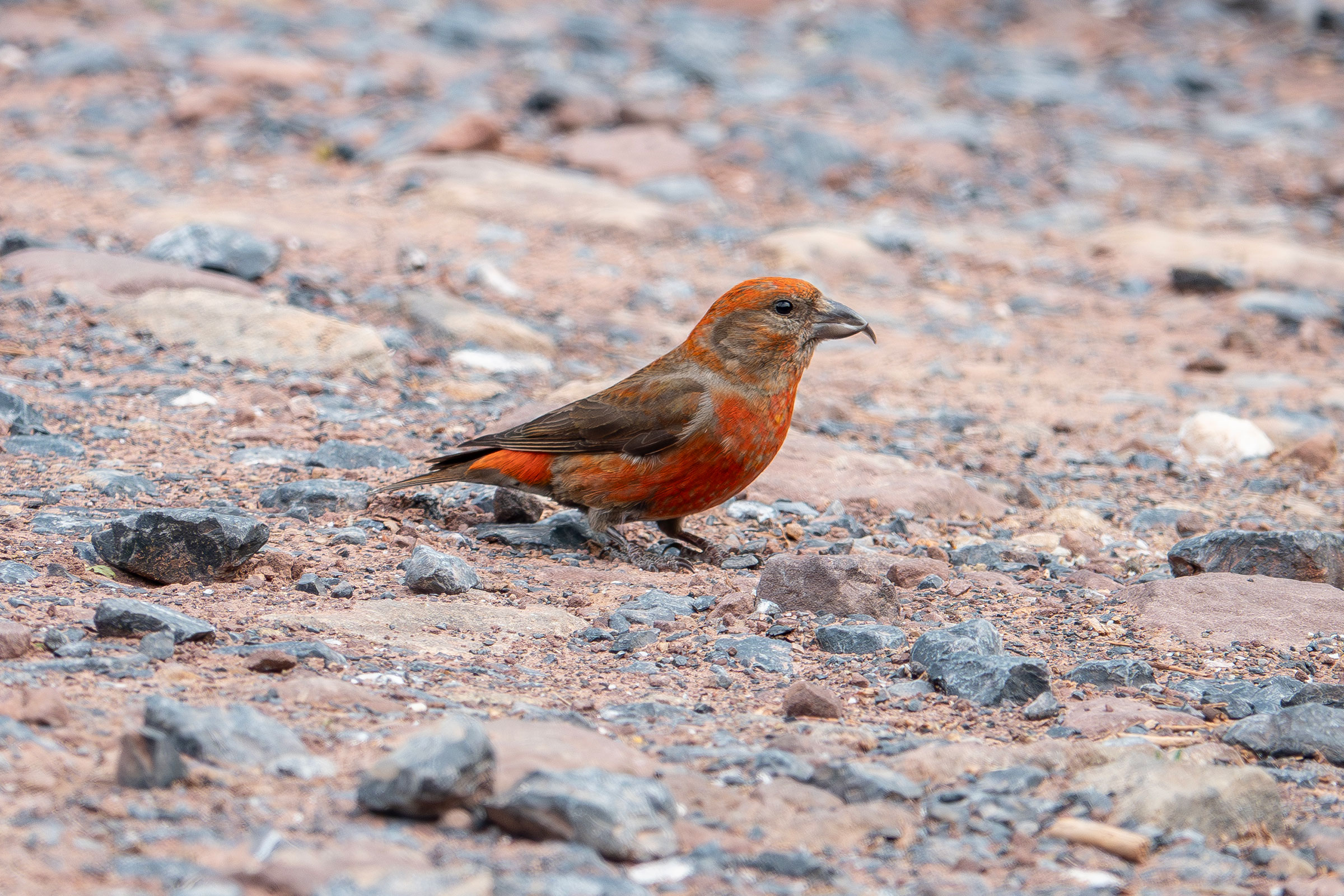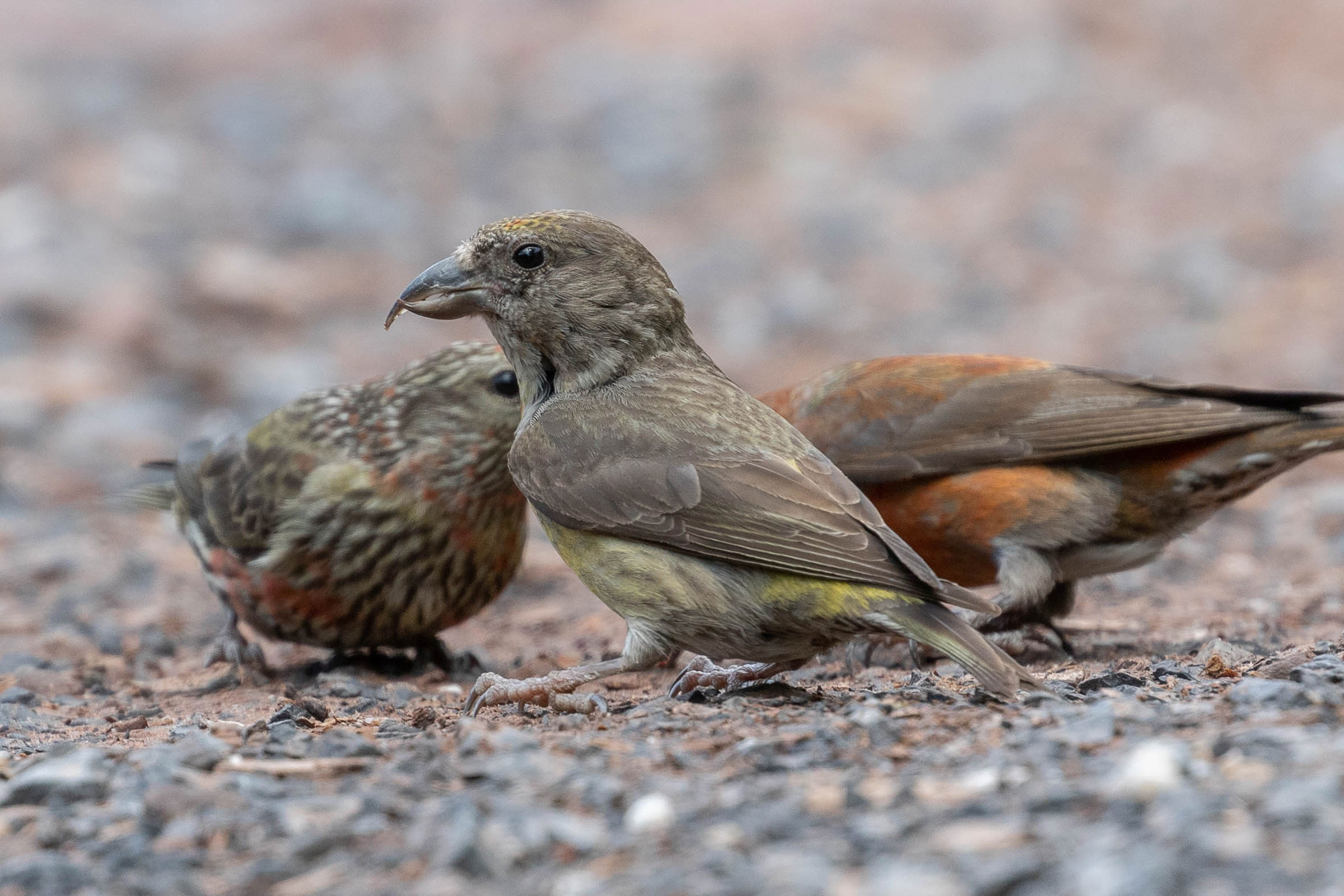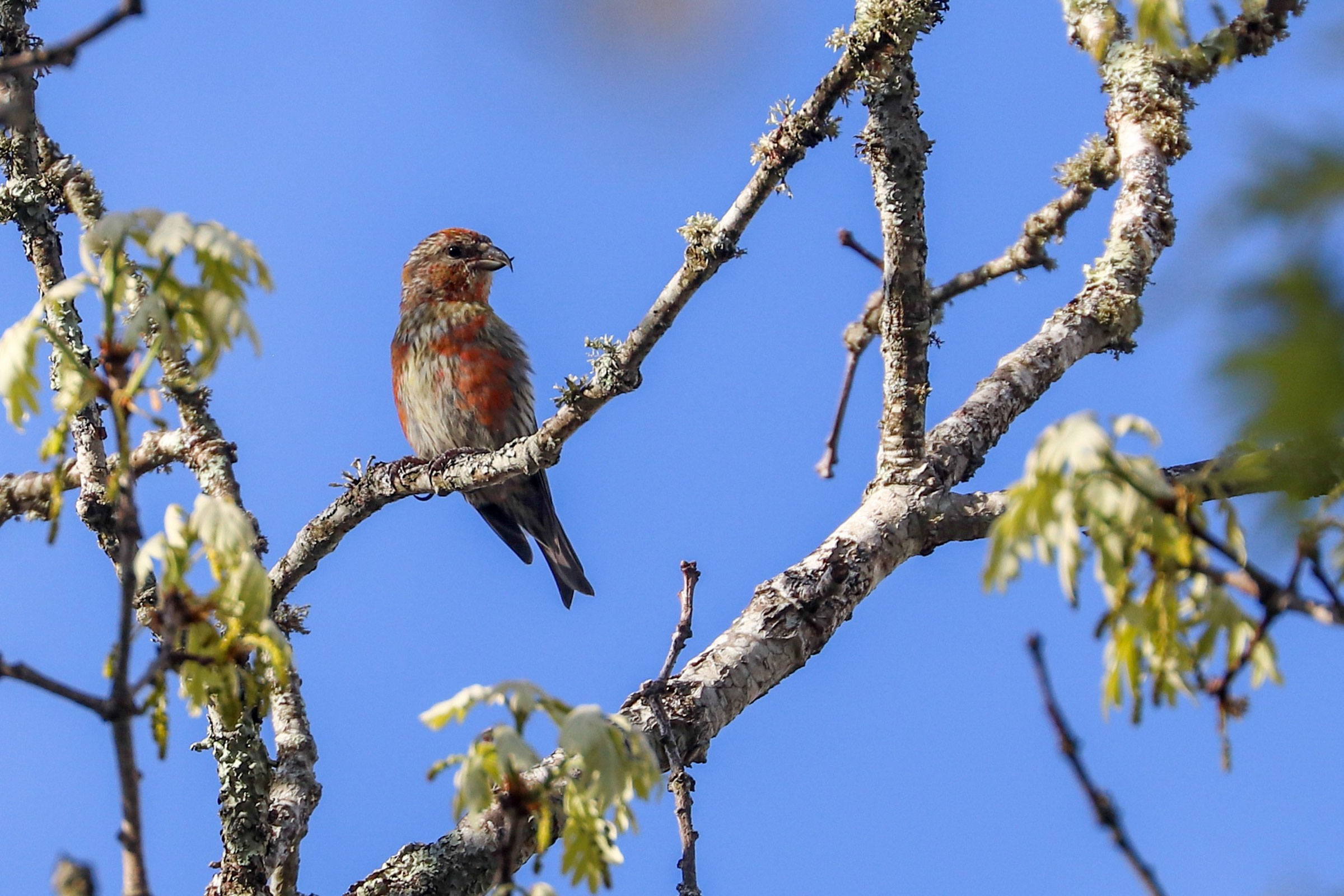Introduction
Red Crossbills consist of at least ten different sub-populations in North America, known by their calls, morphology, and preferred conifer species. In Virginia, we primarily have what is currently known as Type 1 “Appalachian” Red Crossbill, though other call types are known in the state (Rottenborn and Brinkley 2007). They use their crossed bills like crowbars to pry open and feed on soft- to semi-soft-coned conifers such as eastern white pine (Pinus strobus), Virginia pine (Pinus virginiana), pitch pine (Pinus rigida), eastern hemlock (Tsuga canadensis), introduced Norway spruce (Picea abies), and in the highest peaks of the Appalachian Mountains, red spruce (Picea rubens) and balsam fir (Abies balsamea) (Young et al. 2011; Young and Mandelbaum 2022).
Crossbill breeding follows cone crops. Breeding occurs once when cones are developing in late summer to autumn, and if there is a sufficient “bumper” crop, then it occurs a second time during winter to spring (Young et al. 2011; Benkman and Young 2020). Their nomadic habits, cryptic behavior, and restriction to high-elevation habitat make this species difficult to find as a breeder.
Breeding Distribution
Because the species is rare, its distribution could not be modeled. For information on where Red Crossbills occur in Virginia, please see the Breeding Evidence section.
Breeding Evidence
Red Crossbills were only observed breeding in the Mountains and Valleys region (Figure 1). They were confirmed breeders in a single block in Rockingham County, where they bred along the West Virginia line at Briery Branch Gap near Reddish Knob. Probable breeders occurred at sites in an additional nine blocks: Whitetop Mountain in Grayson County, Mountain Lake Biological Station in Giles County, George Washington National Forest in Bath County, Sapling Ridge in Highland County, numerous additional locations near the West Virginia border in Rockingham County, and Elkswallow Wayside in Shenandoah National Park in Page County. These locations were mostly above 3,000 ft (900 m) in elevation. Birds were similarly observed at high-elevation sites during the First Atlas (Figure 2).
A scarcity of records makes it difficult to describe the breeding phenology of crossbills in Virginia. All confirmations were of recently fledged young from May 20 to July 19, with no nests observed (Figure 3). For more general information on the breeding habits of the Red Crossbill, please refer to All About Birds.

Figure 1: Red Crossbill breeding observations from the Second Atlas (2016–2020). The colored boxes illustrate Atlas blocks (approximately 10 mi2 [26 km2] survey units) where the species was detected. The colors show the highest breeding category recorded in a block. The numbers within the colors in the legend correspond to the number of blocks with that breeding evidence category.

Figure 2: Red Crossbill breeding observations from the First Atlas (1985–1989). The colored boxes illustrate Atlas blocks (approximately 10 mi2 [26 km2] survey units) where the species was detected. The colors show the highest breeding category recorded in a block. The numbers within the colors in the legend correspond to the number of blocks with that breeding evidence category.

Figure 3: Red Crossbill phenology: confirmed breeding codes. This graph shows a timeline of confirmed breeding behaviors. Tick marks represent individual observations of the behavior.
Population Status
Due to its rarity, there were too few detections during the Atlas point count surveys to allow development of an abundance model for the Red Crossbill. The North American Breeding Bird Survey (BBS) does not estimate credible trends for this species across the entire eastern portion of its range. The Red Crossbill is a highly mobile tracker of ephemeral resources; thus, breeding and distribution are difficult to capture.
Conservation
Despite its likely small population in Virginia, the Red Crossbill is a representative of spruce-fir forests, a rare and threatened community type. More information is greatly needed on this species. Because no credible trends exist for the Type 1 Red Crossbill, it could not be evaluated as a potential Species of Greatest Conservation Need. It is therefore included in the 2025 Virginia Wildlife Action as an Assessment Priority Species Plan (VDWR 2025). Careful study and audio recording of all Red Crossbills encountered are necessary to determine their call type and breeding status.
Interactive Map
The interactive map contains up to six Atlas layers (probability of occurrence for the First and Second Atlases, change in probability of occurrence between Atlases, breeding evidence for the First and Second Atlases, and abundance for the Second Atlas) that can be viewed one at a time. To view an Atlas map layer, mouse over the layer box in the upper left. County lines and physiographic regional boundaries (Mountains and Valleys, Piedmont, and Coastal Plain) can be turned on and off by checking or unchecking the box below the layer box. Within the map window, users can hover on a block to see its value for each layer and pan and zoom to see roads, towns, and other features of interest that are visible beneath a selected layer.
View Interactive Map in Full Screen
References
Benkman, C. W. and M. A. Young (2020). Red Crossbill (Loxia curvirostra), version 1.0. In Birds of the World (S. M. Billerman, B. K. Keeney, P. G. Rodewald, and T. S. Schulenberg, Editors). Cornell Lab of Ornithology, Ithaca, NY, USA. https://doi.org/10.2173/bow.redcro.01.
Rottenborn, S. C., and E. S. Brinkley (Editors) (2007). Virginia’s birdlife: An annotated checklist. 4th edition. Virginia Society of Ornithology.
Virginia Department of Wildlife Resources (VDWR) (2025). Virginia wildlife action plan. Virginia Department of Wildlife Resources, Henrico, VA, USA. 506 pp.
Young, M. A., K. Blankenship, M. Westphal, and S. Holzman (2011). Status and distribution of Type 1 Red Crossbill: an Appalachian call type? North American Birds 65:554–560.
Young, M. A., and R. F. Mandelbaum (2022). A Crossbill’s guide to conifers of the eastern forest. Finch Research Network. www.finchnetwork.org.




